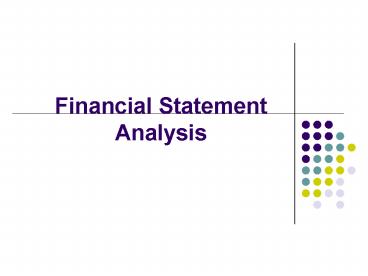Financial Statement Analysis - PowerPoint PPT Presentation
1 / 18
Title:
Financial Statement Analysis
Description:
He was the first to note that security returns appeared to follow a form of geometric Brownian motion (essentially, a random walk). Title: Oil and Gas Business – PowerPoint PPT presentation
Number of Views:77
Avg rating:3.0/5.0
Title: Financial Statement Analysis
1
Financial Statement Analysis
2
Determinants of Intrinsic Value Using Ratio
Analysis
Net operating profit after taxes
Required investments in operating capital
-
Free cash flow (FCF)
FCF1
FCF2
FCF8
...
Value
(1 WACC)1
(1 WACC)8
(1 WACC)2
Weighted average cost of capital (WACC)
Market interest rates
Firms debt/equity mix
Cost of debt Cost of equity
Firms business risk
Market risk aversion
3
Overview
- Ratios facilitate comparison of
- One company over time
- One company versus other companies
- Ratios are used by
- Managers to identify areas of weakness and
strength - Lenders to determine creditworthiness
- Stockholders to estimate future cash flows and
risk
4
RATIO ANALYSIS
- Liquidity Ratios
- Asset Management Ratios
- Debt Management Ratios
- Profitability Ratios
- Market Value Ratios
5
Liquidity Ratios
Can the company meet its short-term obligations
using the resources it currently has on hand?
- Current Ratio
- Quick Ratio
6
Asset Management Ratios
How efficiently does the firm use its assets? How
much does the firm have tied up in assets for
each dollar of sales?
- Inventory Turnover Ratio
- Days Sales Outstanding (DSO), Average Collection
Period (ACP) - Fixed Asset Turnover Ratio
- Total Asset Turnover Ratio
7
Asset Management Ratios
Total assets turnover
Sales Total assets
8
Debt Management Ratios
Does the company have too much debt? Can the
companys earnings meet its debt servicing
requirements?
- Total Liabilities to Total Assets, Long Term Debt
to Total Assets, Debt to Equity Ratio - Times Interests Earned Ratio
- EBITDA Coverage Ratio
9
Debt Management Ratios
EBITDA Coverage Ratio
EBIT Depr. Amort. Lease payments
Interest Lease expense
pmt.
Loan pmt.
10
Profitability Ratios
- What is the companys rate of return on
- Sales?
- Assets?
- Profit Margin on Sales
- Basic Earning Power
- Return on Total Assets
- Return on Common Equity
11
Profit Margin
Gross profit margin (GPM)
Sales - COGS Sales
GPM
12
Basic Earning PowerReturn on Asset, Return on
Equity
13
Market Values Ratios
- Market value ratios incorporate the
- High current levels of earnings and cash flow
increase market value ratios - High expected growth in earnings and cash flow
increases market value ratios - High risk of expected growth in earnings and cash
flow decreases market value ratios
- Price/Earnings Ratio
- Price/Cash Flow Ratio
- Market/Book Value Ratio
14
Market Values Ratios
15
DU PONT EQUATION
16
ANALYTICAL APPROACHES
- Trend Analysis
- Common Size Analysis
- Percent Change Analysis
17
Limitations
- Different divisions in different industries
- Average is not good enough
- Inflation
- Seasonal factors
- Window dressing
- Different accounting practices
- What is a good ratio?
- Financial statements accuracy
18
Qualitative Factors
- Dependence on key customer(s)
- Dependence on key product(s)
- Dependence on key supplier(s)
- Competition
- Future prospects
- Legal regulatory environment































